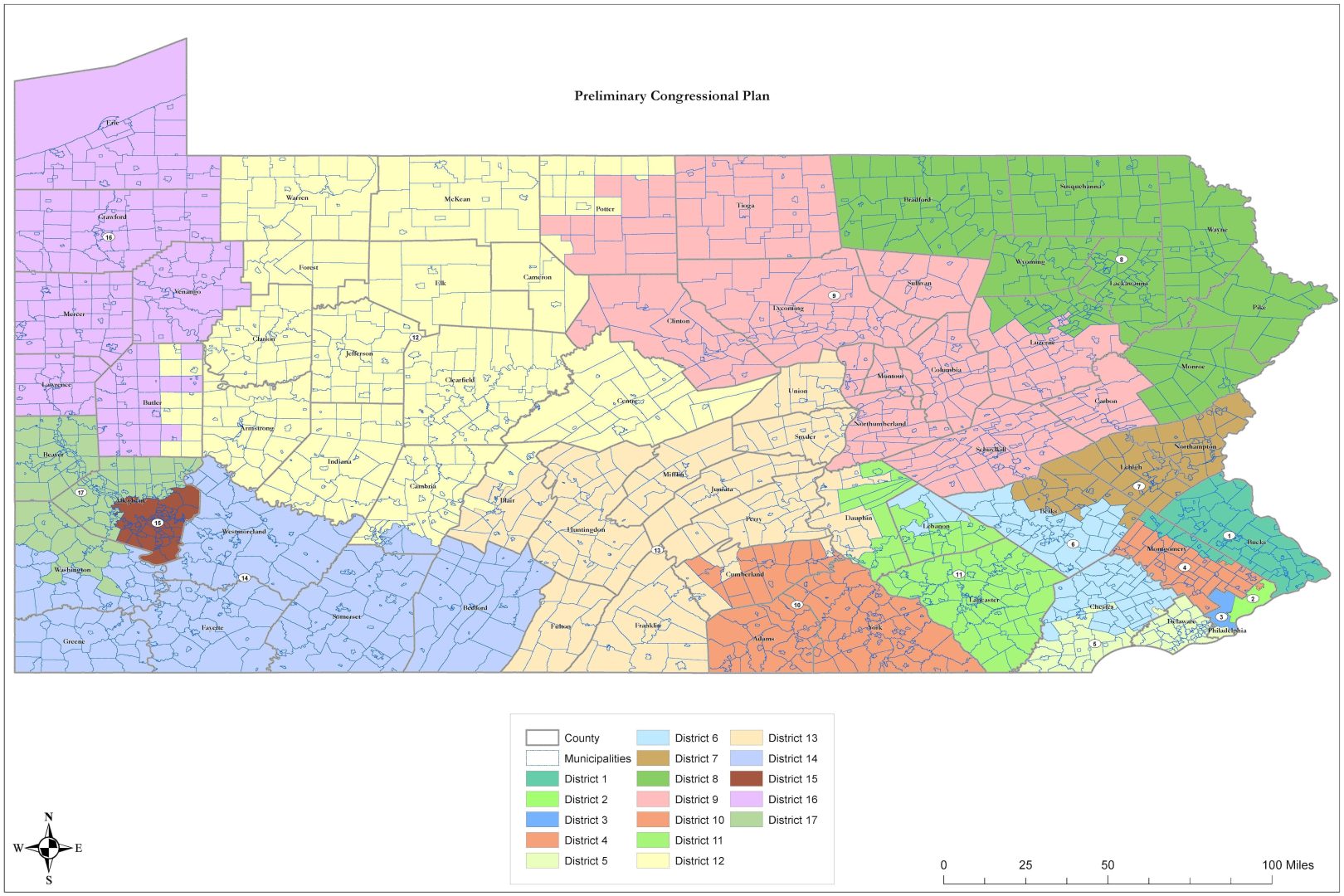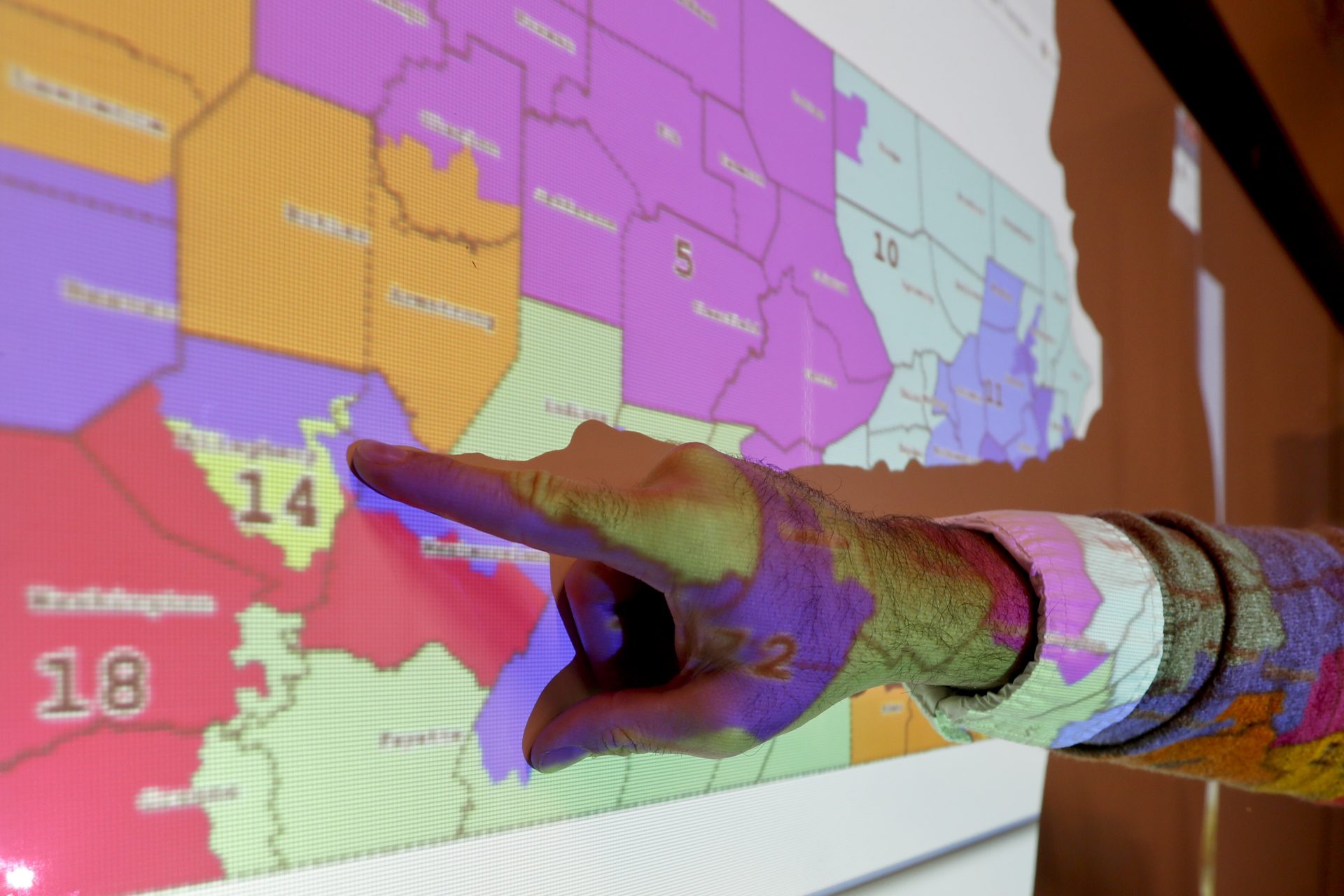
The Pennsylvania House State Government Committee's preliminary congressional map, released Dec. 8.
Pennsylvania House State Government Committee

The Pennsylvania House State Government Committee's preliminary congressional map, released Dec. 8.
Pennsylvania House State Government Committee

Pennsylvania House State Government Committee
The Pennsylvania House State Government Committee's preliminary congressional map, released Dec. 8.
(Harrisburg) — A Pennsylvania state House committee made a set of party-line votes Monday regarding congressional redistricting, which the Republican chairman framed as needed to prepare for final negotiations over the maps.
The State Government Committee met for 20 minutes in the Capitol to approve amendments, bills and a resolution that were all unanimously favored by Republicans and opposed by Democrats.
It approved a resolution that lawmakers who are involved in drawing new congressional maps will not adjust census numbers to allocate state prison inmates to their home areas , as the state legislative map-drawing body has chosen to do.
They also advanced a bill that describes new district lines, but the ranking Democrat on the committee, Rep. Scott Conklin of Centre County, said the legislation was missing an actual map.
Conklin made the same objection to a second bill, which Chairman Seth Grove, R-York, described as a backup that might eventually be needed under the General Assembly’s rules.
“I believe that if you’re going to vote on a map, you should actually have a map present,” Conklin said. “If not, it’s nothing more than a shell game.”

Min Xian / WPSU
Central Pennsylvania residents said they want to see communities kept intact when it comes to congressional redistricting during a listening session with Governor Tom Wolf’s Redistricting Advisory Council Monday.
Conklin, other Democrats and advocates said they worry the House is teeing up a similar redistricting process to 2011, despite promises to make this cycle’s redraw the “most open and transparent congressional redistricting process in Pennsylvania history.”
At that time, lawmakers didn’t put forward a final map until months of private negotiations had finished. Republicans shepherded that map through the legislature and then-Republican Gov. Tom Corbett signed off on it in less than two weeks — without any public input.
That map was later tossed out by the Pennsylvania Supreme Court for being unconstitutionally gerrymandered in favor of Republicans.
“We did…what was always done in the past: we keep the public out of the process and we do what we want to do. That’s not transparency,” Conklin said.
House Republican spokesman Jason Gottesman pushed back on social media, saying Democrats have been given opportunities to submit maps and comment on what’s being proposed.
“To unjustifiably complain now that they had no chance to participate in the process only underscores that their only agenda is to draw maps that favor Democrats,” Gottesman said.
Two Republicans, Rep. Russ Diamond and Rep. Frank Ryan, said late last week they “cannot support” the preliminary proposal because their home county of Lebanon would be split between two districts. Both are members of the powerful House State Government committee, which must approve a map proposal for it to move forward.
In an interview Monday, Ryan said he would vote ‘no’ on it in its current form.
“They’ve split up school districts, they’ve split up communities of interest,” he said. “People who are very closely aligned with one another are in different Congressional districts, and so it weakens their representation.”
The new congressional map must account for the loss of one seat, dropping the state’s D.C. delegation from 18 to 17 starting with the 2022 races. Congressional redistricting is handled as legislation, requiring approval by both chambers and the governor.
The legislative maps, which cover the 203-person state House and 50-member state Senate, are being developed by the five-person Legislative Reapportionment Commission. A preliminary map from the commission could surface at any time.
The parallel processes for Congress and the General Assembly are running up against deadlines designed to keep in place a schedule of public review, legal challenges and petition circulation periods with a goal of having a primary election on May 17.
“Any decision to move the primary would have to originate in the Legislature,” said Beth Rementer, press secretary for Democratic Gov. Tom Wolf. “That said, the governor believes that it is critical that next year’s primary be held on new maps, and believes the primary should be moved if necessary to ensure maps can be completed with appropriate transparency and opportunity for comment.”
The Department of State has said a May 17 primary means there’s a Jan. 24 deadline to leave enough time for counties to prepare the documents needed for candidates to begin circulating nominating petitions on Feb. 15.
Carol Kuniholm, who chairs the advocacy group Fair Districts PA, said it may already be too late to keep the primary date intact. If not, “something’s going to have to get shortened,” she said.
“I don’t think it’s possible to have it on May 17,” she said. “I do think it’s possible to have it by early to mid June.”
The Legislative Reapportionment Commission’s chairman, former University of Pittsburgh Chancellor Mark Nordenberg, said about a week ago that he may soon talk publicly about his group’s timeline.
“Since we have no authority with respect to primary election deadlines, I have avoided discussing that topic and am simply focused on the work of the reapportionment commission,” he said in an email.
Continued delays could force lawmakers to decide whether to push back the primary, as occurred last year because of the pandemic, or consider running elections for another cycle on existing maps.

Keith Srakocic / AP Photo
William Marx points out one of the districts that crossed four counties as an image of the old congressional districts of Pennsylvania are projected on a wall in the classroom where he teaches civics in Pittsburgh on Friday, Nov. 16, 2018. Marx was a plaintiff in the Pennsylvania lawsuit that successfully challenged the Republican-drawn congressional maps. Marx said he believes the new district boundaries resulted in “a more fair congressional representation of the will of the people in Pennsylvania.”
“I think at this point, all the pieces have to fall in place exactly right” to meet current deadlines, said County Commissioners Association of Pennsylvania executive director Lisa Schaefer.
If legislative leaders want to prevent decisions being made by judges, “then do your jobs and produce the maps,” said David Thornburgh with the Philadelphia-based good government group the Committee of Seventy.
Thornburgh said getting the congressional maps done is more urgent than Legislative maps “because there’s no way we can reuse the current districts one more time. You can’t have 18 people running for 17 seats.”
As part of WITF’s commitment to standing with facts, and because the Jan. 6 attack on the U.S. Capitol was an attempt to overthrow representative democracy in America, we are marking elected officials’ connections to the insurrection. Read more about this commitment.
Reps. Grove (R-York) and Ryan (R-Lebanon) are among the several dozen lawmakers who signed a letter asking Congress to object to Pennsylvania’s electoral college vote –despite no evidence that would call those results into question.
This supported the election-fraud lie, which led to the attack on the Capitol.

Get insights into WITF’s newsroom and an invitation to join in the pursuit of trustworthy journalism.
The days of journalism’s one-way street of simply producing stories for the public have long been over. Now, it’s time to find better ways to interact with you and ensure we meet your high standards of what a credible media organization should be.